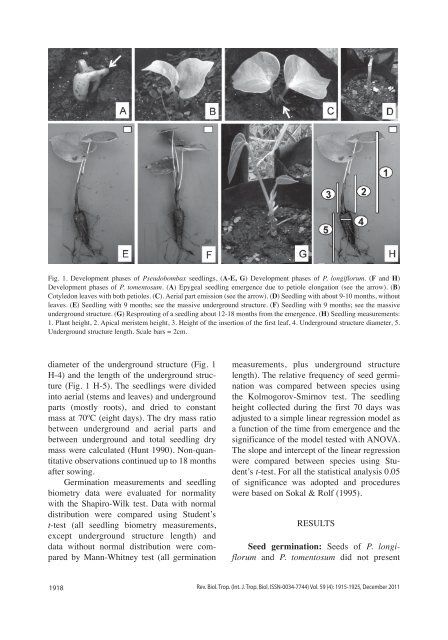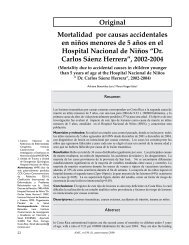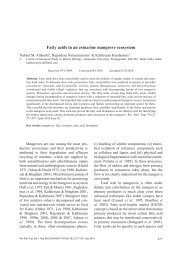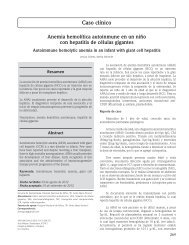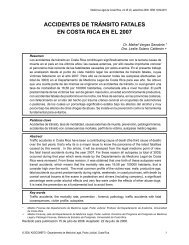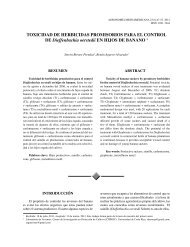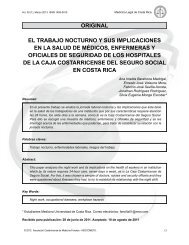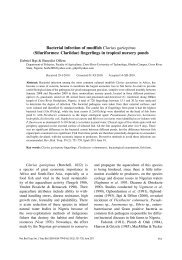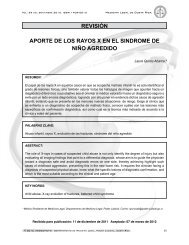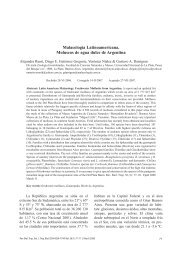Seed germination and seedling growth of two Pseudobombax species
Seed germination and seedling growth of two Pseudobombax species
Seed germination and seedling growth of two Pseudobombax species
Create successful ePaper yourself
Turn your PDF publications into a flip-book with our unique Google optimized e-Paper software.
Fig. 1. Development phases <strong>of</strong> <strong>Pseudobombax</strong> <strong>seedling</strong>s, (A-E, G) Development phases <strong>of</strong> P. longiflorum. (F <strong>and</strong> H)<br />
Development phases <strong>of</strong> P. tomentosum. (A) Epygeal <strong>seedling</strong> emergence due to petiole elongation (see the arrow). (B)<br />
Cotyledon leaves with both petioles. (C). Aerial part emission (see the arrow). (D) <strong>Seed</strong>ling with about 9-10 months, without<br />
leaves. (E) <strong>Seed</strong>ling with 9 months; see the massive underground structure. (F) <strong>Seed</strong>ling with 9 months; see the massive<br />
underground structure. (G) Resprouting <strong>of</strong> a <strong>seedling</strong> about 12-18 months from the emergence. (H) <strong>Seed</strong>ling measurements:<br />
1. Plant height, 2. Apical meristem height, 3. Height <strong>of</strong> the insertion <strong>of</strong> the first leaf, 4. Underground structure diameter, 5.<br />
Underground structure length. Scale bars = 2cm.<br />
diameter <strong>of</strong> the underground structure (Fig. 1<br />
H-4) <strong>and</strong> the length <strong>of</strong> the underground structure<br />
(Fig. 1 H-5). The <strong>seedling</strong>s were divided<br />
into aerial (stems <strong>and</strong> leaves) <strong>and</strong> underground<br />
parts (mostly roots), <strong>and</strong> dried to constant<br />
mass at 70ºC (eight days). The dry mass ratio<br />
between underground <strong>and</strong> aerial parts <strong>and</strong><br />
between underground <strong>and</strong> total <strong>seedling</strong> dry<br />
mass were calculated (Hunt 1990). Non-quantitative<br />
observations continued up to 18 months<br />
after sowing.<br />
Germination measurements <strong>and</strong> <strong>seedling</strong><br />
biometry data were evaluated for normality<br />
with the Shapiro-Wilk test. Data with normal<br />
distribution were compared using Student’s<br />
t-test (all <strong>seedling</strong> biometry measurements,<br />
except underground structure length) <strong>and</strong><br />
data without normal distribution were compared<br />
by Mann-Whitney test (all <strong>germination</strong><br />
measurements, plus underground structure<br />
length). The relative frequency <strong>of</strong> seed <strong>germination</strong><br />
was compared between <strong>species</strong> using<br />
the Kolmogorov-Smirnov test. The <strong>seedling</strong><br />
height collected during the first 70 days was<br />
adjusted to a simple linear regression model as<br />
a function <strong>of</strong> the time from emergence <strong>and</strong> the<br />
significance <strong>of</strong> the model tested with ANOVA.<br />
The slope <strong>and</strong> intercept <strong>of</strong> the linear regression<br />
were compared between <strong>species</strong> using Student’s<br />
t-test. For all the statistical analysis 0.05<br />
<strong>of</strong> significance was adopted <strong>and</strong> procedures<br />
were based on Sokal & Rolf (1995).<br />
RESULTS<br />
<strong>Seed</strong> <strong>germination</strong>: <strong>Seed</strong>s <strong>of</strong> P. longiflorum<br />
<strong>and</strong> P. tomentosum did not present<br />
1918 Rev. Biol. Trop. (Int. J. Trop. Biol. ISSN-0034-7744) Vol. 59 (4): 1915-1925, December 2011


